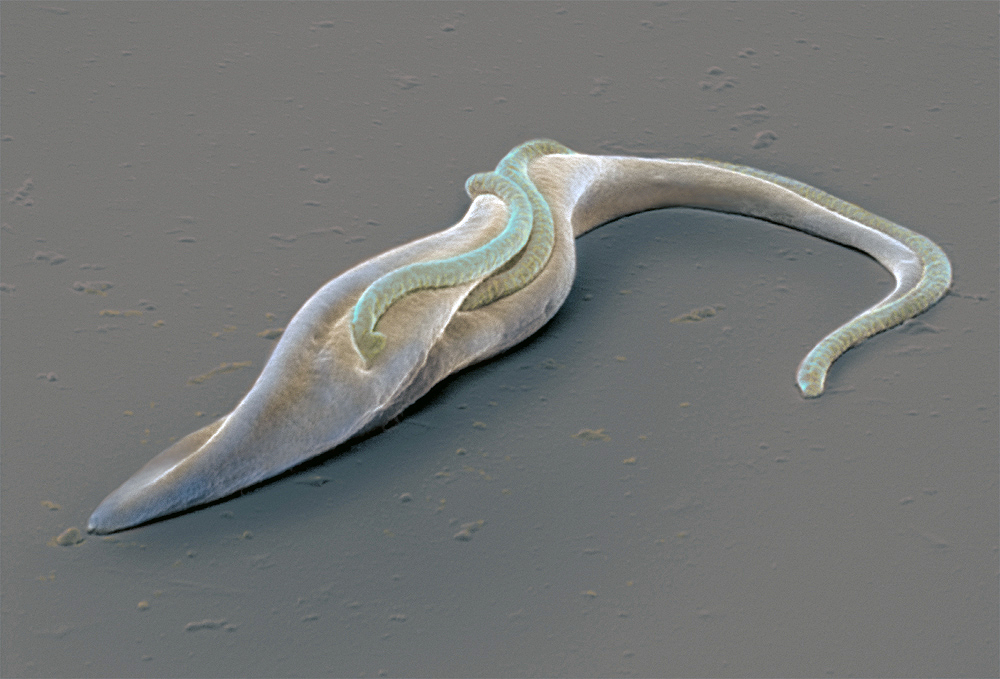An unusual delivery service
Is it better to produce locally or to import? That can be a crucial question for simple lifeforms as well. Mitochondria, the power plants of the cell, have their own protein factories although the cell apparatus could easily do the job for them. A special species of eukaryotes even has all the transfer-RNA it needs for protein assembly promptly delivered. Researchers from the University of Bern have now uncovered how this highly unusual import mechanism works in detail.
There are two reasons why trypanosomes, little unicellular organisms, are of special interest for researchers. For one, trypanosomes cause various diseases, including the fatal human sleeping sickness, for which still no good treatment is known. But maybe even more interesting is the biochemical extravaganza the trypanosomes are famous for. They have special ways of accomplishing things when it comes to basic cellular mechanisms. And these ways are as mysterious as revelatory – for human biology too. Understanding the deviations in basic mechanisms in other organisms can lead to valuable insights into the characteristics of our own cells.
Mysterious effort for a protein machinery
One of these mysteries has proven to be especially intriguing for the research group of André Schneider from the Department of Chemistry and Biochemistry of the University of Bern. It has to do with mitochondria, the power plants of the cell. These organelles are thought to have been independent lifeforms in the early eras of evolution, to then to be kidnapped by other cells. That is why they still possess their own gene material and the machinery to translate it, to fabricate proteins. Mitochondria therefore could in principle have a certain autonomy in their function, but they are making only very spare use of it: In human cells, the mitochondrial genome contains only 13 protein-coding genes, whereas about 1500 other proteins are produced by the normal cell machinery to be imported into the mitochondria later. Why all this effort to run a proper protein machinery if you can just as well obtain all the proteins from an external source? What puzzles human biologists is even stranger in the case of trypanosomes. Scientific consensus is that this import business works for proteins only – the tRNAs necessary for the fabrication of mitochondrial proteins need to be produced by the the mitochondria itself. But strangely enough the trypanosome mitochondria are lacking all the genes for this task – apparently the factory has to be provided with these components as well.
Hypothesis proven wrong
The researchers from Bern and their colleagues from the Universities Freiburg and Bremen were fascinated by this – and they decided to figure out how these tRNAs find their way into the mitochondria. "By the book you would expect that on a molecular level all the processes in mitochondria are very similar, over all eukaryote species – but in this case there are striking differences", says André Schneider. Which is interesting from an evolutionary point of view as well: understanding these differences can lead to hints for how the history of life has evolved in detail. Recently the group has been able to show (in an article in the Journal PNAS) that the protein import channels in the membrane of mitochondria are used for the import of tRNA as well. This has been suggested before, but with the hypothesis that tRNA would be something of a stowaway, smuggled into the mitochondria in complex with a protein. With the help of several experiments, this mechanism in the case of trypanosomes has now been shown to be wrong: tRNA import is independent from imported proteins. How exactly the import channel accomplishes this supplementary task will be the subject of future research.
These insights might lead to new paths in pharmaceutical research. The big problem with sleeping sickness therapeutics is that these trypanosome pathogens are eukaryotes as well, just like us humans. So their functioning is much more similar to that of our cells, than for instance to that of bacteria. This makes it much harder to find efficient drugs with not too many serious side effects. If one can find ways to block this newly discovered import function this could lead to new drug targets. On the other hand, André Schneider could imagine a kind of 'upgrade' for human cells as well: maybe by using experimental tricks tRNA import could be switched on in human cells as well. This would open up new therapeutical options for mitochondrial diseases by the means of gene therapy – which often makes use of RNA. Today it is not possible to get these therapeutical agents into the mitochondria.
|
«RNA & Disease – The Role of RNA Biology in Disease Mechanisms» |
Publication details: Niemann M., Harsman A., Mani J., Peikert C.D., Oeljeklaus S., Warscheid B., Wagner R., Schneider A.: tRNAs and proteins use the same import channel for translocation across the mitochondrial outer membrane of trypanosomes. PNAS 2017 ; published ahead of print August 28, 2017, doi:10.1073/pnas.1711430114
2017/08/30


